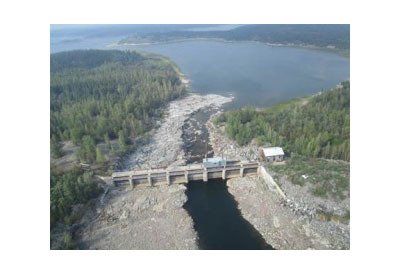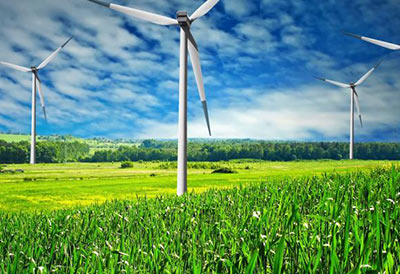Le Yukon, les T.-N.-O et le Nunavut sont très différents face aux énergies renouvelables

L’électricité – la façon dont elle est produite et son coût sont deux enjeux très importants dans le nord du pays. La façon de faire face aux changements climatiques soulève les mêmes enjeux. Ainsi, les contribuables et les élus demandent aux gouvernements de ces provinces, territoires et états de produire de l’électricité en dépensant moins et de prendre le virage vers les énergies renouvelables. Mais selon l’endroit que vous habitez dans le Nord, certaines choses sont plus faciles à dire qu’à faire.
Le Yukon est presque 100 % énergie renouvelable. En effet, en 2013, Yukon Energy a généré 99,5 % de son électricité via des installations hydro-électriques ou éoliennes.
Les Territoires du Nord-Ouest produisent environ 80 % de son électricité avec l’hydro-électricité. Tout comme pour le Yukon, les TNO ne sont pas branchés sur le réseau du sud, ce qui signifie qu’ils ne peuvent importer des énergies moins coûteuses du sud.
Le Nunavut est très très loin des énergies renouvelables. Ce territoire est presque entièrement dépendant à l’énergie générée par le diesel, sauf des très petites productions d’électricité solaire et éolienne.
Lisez les détails dans cet article en anglais, où on se penche sur les enjeux spécifiques du Yukon, des Territoires du Nord-Ouest et du Nunavut et où on présente un portrait de leur situation actuelle.
Electricity — how we generate it and how much it costs — is a perpetual hot-button issue in the North. The same is true for climate change. That has ratepayers and politicians alike calling for Northern governments to produce cheaper power and to shift away from fossil fuel generation towards renewable energy. But depending on where you live in the North, that may be easier said than done.
Yukon
The good news for Yukon is that it’s almost at 100% renewable energy already. In 2013, Yukon Energy generated 99.5% of its electricity via hydroelectric dams and wind. Diesel generators are used almost exclusively for backup in the winter when demands rise and hydro generation declines.
Even so, Yukon Energy still wants to reduce the amount of diesel it relies on. That’s why it’s building a new backup generator, fired by liquified natural gas, to replace two aging diesel gensets in Whitehorse.
The cost was originally pegged at around $39 million, but Yukon Energy spokeswoman Janet Patterson said changes to the project mandated by the Yukon Environmental and Socio-economic Assessment Board have thrown that figure into flux.
Yukon Energy estimates the new LNG generators would save the utility $2.2 million per year and slash carbon emissions.
“The reduction of life-cycle emissions in terms of greenhouse gas emissions would be 26%,” Patterson said.
Critics of the project argue it puts off further investments in renewable energy and serves as a trojan horse to bring fracking for natural gas to Yukon (the current plan is to truck LNG in from British Columbia). But Patterson argues the current state of wind and solar power make them unsuited to producing power on demand when temperatures drop and loads increase, and a transmission line connection to BC would cost around $1.5 billion, a bill that’s too steep to pass on to ratepayers.
“Let’s say there’s a power outage and it’s -40 C. We can’t just call up our neighbour and say, ‘We need more power.’ We have to come up with it ourselves and… it has to always be available to us.”
NWT
The Northwest Territories, ever the middle child in Northern affairs, produces about 80% of its electricity with hydro. Like Yukon, it isn’t connected to the southern grid, meaning it can’t import cheaper southern power.
Low water levels in the NWT this summer affected the Snare hydro system’s electricity output. The photo shows the low water levels at one of the dams in the Snare system. The NWT’s own system, with the Snare hydro near Yellowknife, and the Talston hydro dam near Fort Smith, effectively comprises two separate grids. And even hydro isn’t immune to fluctuations in supply: dry weather this summer required the Northwest Territories Power Corporation to burn about $20 million in extra diesel to keep up with demand. That’s on top of the $25 million in diesel NTPC burns every year for backup and in off-grid communities.
In the past decade, the GNWT has spent around $21 million on various studies for renewable energy and transmission line projects for smaller communities, including solar, hydro and geothermal. But the NWT is a long way from fully renewable power, said Andrew Stewart, the director of business development for NT Energy, NTPC’s renewable energy sister company.
“It will eventually be possible – some would say even required, as fossil fuel supplies dwindle – but that is decades away,” Stewart wrote in an email. “There is also the view that with enough money, anything is possible today.”
The government is backing away from its original plan to link the NWT’s two grids to one another and to the south. Original estimates put the project cost at around $700 million, but new estimates are closer to $1.2 billion, which is more than the territory can afford, said finance minister Michael Miltenberger.
Meanwhile, the GNWT has an energy charrette, a planning meeting, which will hear from experts, governments and industry scheduled for early November.
“There is a strong [financial] commitment coming as a result of the meetings,” said a senior government source. That likely means a major push on renewable energy.
Nunavut
Nunavut is a long, long way from generating more than a token amount of renewable energy. The territory is almost entirely dependent on diesel-generated power, apart from tiny amounts of wind and solar power.
Qulliq Energy, Nunavut’s utility, imports around 45 million litres of diesel fuel every year into the territory.
At last count, diesel produced 99.94% of Nunavut’s electricity. There’s no grid at all: each community is served by its own diesel-fired power plant. Many of those plants are at or near the end of their design lives.
While Qulliq Energy, Nunavut’s utility, has upgraded several plants over the last few years, including a $30-million upgrade to diesel generators in Iqaluit that added 10 megawatts of new capacity, it still imports around 45 million litres of diesel fuel every year.
In 2010, according to Alberta Oil magazine, Nunavut spent $39 million on diesel. According to Qulliq’s most recent application to the Utility Rates Review Council, that figure has climbed by $12 million since, meaning Nunavut now spends more than $50 million per year to keep the lights on.
While hydro offers a cheaper source of power over the long term, Nunavut lacks the cash to pay for the expensive upfront capital costs of a hydro dam. Qulliq has had plans for a hydroelectric plant that would generate between 16 and 25 megawatts near Iqaluit for nearly a decade, but progress has been slow. Cost estimates for the project are around $450 million. And in 2008, QEC conducted a desktop study for hydro power at various sites in the Kivalliq region, with an estimated price tag of $380 million.
Alain Barriault, QEC’s newly-appointed president, said there’s been no further work done on the Kivalliq project. He said the Hudson Bay Neighbours Regional Roundtable, made up of leaders from Nunavut and Manitoba, has recently struck a working group to take a new look at old plans to build a transmission line that would bring hydro power from Manitoba into the rapidly-growing Kivalliq region.
“How that turns out, we’ll have to wait and see,” he said.
Barriault said QEC is serious about pursuing “alternate funding” for the Iqaluit hydro project, including public-private partnerships and deals with the Qikiqtani Inuit Association.
“There are partnerships that we can strike to make this more affordable,” Barriault said. “Other people have an interest in providing affordable energy and can invest in it… We’re looking at proving a business case so the power we provide is going to be affordable to our ratepayers.”
Source: Chris Windeyer, CBC News, http://www.cbc.ca/news/canada/north/yukon-n-w-t-and-nunavut-differ-in-outlooks-for-renewable-energy-1.2804345












